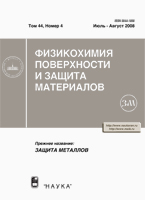Electrodeposition and Physico-Mechanical Properties of Chromium Coatings Modified with Disperse Particles
E. G. Vinokurova, A. M. Arsenkinb, K. V. Grigorovichb, and V. V. Bondar’c
a Mendeleev University of Chemical Technology,
Miusskaya pl. 9, Moscow, 125047 Russia
b Baikov Institute of Metallurgy, Russian Academy of Sciences,
Leninskii pr. 49, Moscow, 117047 Russia
c All-Russian Institute of Scientific and Technical Information,
Russian Academy of Sciences, Moscow, Russia
Received June 25, 2004
Abstract — Chromium electroplates from Cr(III)-baths modified with disperse phases of CeO2 , Cr2O3 , graphite, and ultradisperse diamond are studied. Mechanical properties of the composite coatings are investigated. The Cr2O3-particles present in the bath are found to cause the destruction of the coatings already during the plating. When modifying with CeO2-particles, good coatings with enhanced microhardness can be obtained at their concentration in the bath of no more than 15 g/l. The deposition rate in such cases exceeds that in the blank baths. The optimum range of the CeO2-particle concentration, allowing to obtain the maximal microhardness, is 5–8 g/l. The self-lubricating chromium–graphite composite coatings can be deposited at a graphite concentration in the bath of up to 4 g/l. The microhardness of the chromium coatings is most strongly affected by ultradisperse diamond particles that increase the microhardness by a factor of 1.4; they also decrease the coatings’ brittleness. When the ultradisperse diamond concentration in the solution is as high as 30 g/l, the diamond content in the composite coating reaches its limiting value of 12–14 vol % (or 6.4–7.2 wt %). The optimum ultradisperse diamond concentration was found to be 17 g/l in the baths and 10.5 vol % (or 5.6 wt %) in the composite coating. At these concentrations, the coatings with the maximum microhardness and lowest brittle-ness are obtained.
DOI: 10.1134/S0033173206030131

